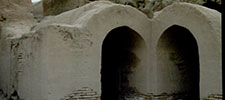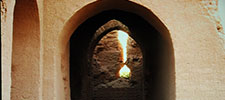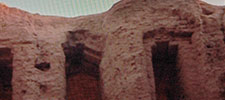Kirk-Kiz monuments
One of the most impressive medieval monuments from the post-Mongol period is Kirk-Kiz. Located outside the walls of medieval Termez, it was probably the fortified residence of a noble family.
This remarkable intact structure of the gth century, with a square layout, with each side being 54 meters long, vividly reminds you a fort with strong turrets. However, the cylindrical turrets have no embrasures, and they are not connected with the rest of the castle. The high walls, perfectly aligned with the four cardinal points of the compass, have narrow windows at the level of the second floor. These windows look more like embrasures.
The entrances are in four deep niches, with arched embrasures above them. The inside of Kirk-Kiz is divided by passages into four parts. An elbowed corridor from central hall or the yard led to each of the parts; from the corridor it was possible to enter five large rooms. All of them were made of adobe bricks; their vaulted ceilings
were of different designs - arched, domed,or torispherical. The architects who built the building were very innovative; they went far beyond the architectural forms of their time. They developed a sophisticated system of pendentives to support vaulted ceilings. Their many-vaulted hall with pylons was a striking example of the architectural traditions of the 5th - 8th centuries.
Most likely, this structure was initially used as a country residence of the local ruler. It was well fortified to resist enemy attacks. But later it was reconstructed and became a hanaka on one of the Great Silk Roads. Here merchants and other travelers could find shelter from bad weather and brigands as well as conveniently stow their goods and accommodate their oack animals.
It is interesting that local people call the area of Kirk-Kiz and the nearby villages 'Shakhri Saman' which means 'The Samans' Town'. According to medieval historians and chroniclers on this very place there once stood the family castle of the founder of the famous Samanids dynasty, which was the first to unite the Central Asian lands.



